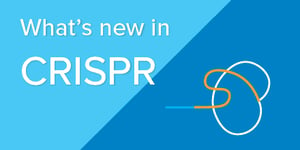 In this quarterly blog series, we’ll highlight a few of the new CRISPR plasmids available at Addgene. We will still periodically focus on specific CRISPR plasmid tools more in-depth, but we hope that this blog series will help you find new CRISPR tools for your research.
In this quarterly blog series, we’ll highlight a few of the new CRISPR plasmids available at Addgene. We will still periodically focus on specific CRISPR plasmid tools more in-depth, but we hope that this blog series will help you find new CRISPR tools for your research.
CRISPR-Cas12b for human genome editing
The best studied Cas12b nuclease from Alicyclobacillus acidoterrestris (AacCas12b) exhibits optimal DNA cleavage at 48 °C, a temperature incompatible to genome editing in human cells. The Feng Zhang lab identified a Cas12b from Bacillus hisashii, BhCas12b that is functional at 37 °C but preferentially nicks the non-target DNA strand. The lab then found gain-of-function mutations that allows it to be repurposed for double strand breaks at target sites.
-
Read the paper in Nature Communications
-
Find the Cas12b plasmids
Plant base editing with a Cas9-adenosine deaminase fusion
Caixia Gao’s lab has developed a new plant base editor from an evolved tRNA adenosine deaminase that is fused to a nicking Cas9. This base editor can be used for A•T to G•C edits in protoplasts or plants of rice and wheat.
-
Read the paper in Genome Biology
Spatially and temporally regulated AAV-based genome editing
In 2016, Jonathan Ploski’s lab developed a viral mediated genome editing system that could be regulated by doxycycline. Now, they’ve developed another AAV toolkit - this time using the Staphylococcus aureus Cas9 (SaCas9). This AAV-based genome editing system is regulated not only temporally with doxycycline, but it can also be regulated spatially with Cre-recombination.
-
Read the paper in Frontiers in Molecular Neuroscience
String assembly gRNA cloning (STAgR)
String assembly gRNA cloning (STAgR), developed by Stefan Stricker’s lab, is a single step gRNA multiplexing system that generates vectors containing high numbers of gRNAs in one overnight reaction. STAgR is highly customizable as vector backbones, and gRNA structure, numbers, and promoters can all be chosen.
-
Read the paper in PLoS One
-
Find the STAgR cloning plasmids
Mobile-CRISPRi allows CRISPRi experiments in diverse bacteria
Carol Gross’s lab recently deposited “Mobile-CRISPRi” plasmids, a set of modular CRISPRi tools that can be used in diverse bacteria from various environments. It has the advantage of stable genomic integration and is easily transferred via conjugation.
-
Read the paper in Nature Microbiology
-
Find the Mobile-CRISPRi plasmids
Identification of Cas12a inhibitors
Using a bioinformatics and a screening approach, the Jennifer Doudna lab identified three different Cas12a inhibitors. Some of these anti-Cas12a proteins have broad inhibitory effects on Cas12a orthologs and can block Cas12a-mediated genome editing in human cells.
-
Read the paper in Science
-
Find the anti-CRISPR expression plasmids
CRISPR-based method for cell lineage tracing
Valcyrie is a CRISPR-based marker excision method for marking distinct cell clones developed by the Michalis Averof lab. It’s an alternative to the conventional Cre or Flp recombinases used to excise markers. It has the advantage that CRISPR efficiency can be controlled by manipulating complementarity between the gRNA and target.
-
Read the paper in Development
-
Find the Valcyrie plasmids
If you have a new CRISPR tool you’ve recently deposited to Addgene and you’d like it to be included in the next What’s New in CRISPR blog post, please let us know!
Additional resources on the Addgene blog
- Download the CRISPR 101 eBook
- Find our CRISPR 101 blog posts
- Read our CRISPR cheat sheet
Resources on Addgene.org
- Read our CRISPR guide
- Find CRISPR plasmids by function
- Find recently deposited plasmids
Topics: CRISPR, Other CRISPR Tools






Leave a Comment